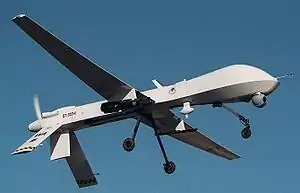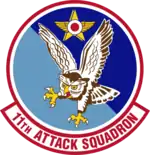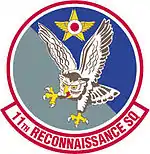11th Attack Squadron
The 11th Attack Squadron is a United States Air Force unit assigned to the 432d Wing Air Combat Command at Creech Air Force Base near Indian Springs, Nevada. It flies General Atomics MQ-9 Reaper Unmanned aerial vehicles. In 1995 the 11th became the first Remotely Piloted Aircraft (RPA) squadron in the Air Force.[5]
11th Attack Squadron
 | |
|---|---|
 | |
| Active | 1942-1946; 1947-1949; 1953-1960; 1966-1971; 1971-1979; 1991-1994; 1995-present |
| Country | |
| Branch | |
| Role | Aerial reconnaissance |
| Part of | Air Combat Command |
| Garrison/HQ | Creech Air Force Base |
| Motto(s) | We Let You Know Before You Go (1953-1966) |
| Engagements | Vietnam War[2] |
| Decorations | Presidential Unit Citation; Air Force Meritorious Unit Award; Air Force Outstanding Unit Award w/Combat "V" Device; Air Force Outstanding Unit Award; Vietnamese Gallantry Cross with Palm[2] |
| Insignia | |
| 11th Attack Squadron emblem |  |
| 11th Reconnaissance Squadron emblem (approved 20 July 1966)[2] |  |
| 11th Tactical Reconnaissance Squadron emblem (approved 28 December 1953)[3] |  |
| 11th Observation Squadron emblem (approved 26 October 1942)[4] |  |
Overview
The 11th Attack Squadron was the U.S. Air Force's first MQ-1B Predator formal training unit that conducts 5 basic and advanced training courses: Initial Qualification, Instructor Upgrade Training, Foreign Officer Course, Senior Officer Course, and Launch & Recovery Course.[6] The 11th conducts intelligence, surveillance, and reconnaissance operating the flies MQ-9 Reaper remotely piloted aircraft.
History
World War II
The squadron was first activated as the 11th Observation Squadron at Wheeler-Sack Field in early 1942. It initially operated in the southeastern United States under Third Air Force flying antisubmarine patrols along the Gulf Coast after the Japanese attack on Pearl Harbor.
The unit was reassigned to Fourth Air Force in Southern California during early 1942, flying reconnaissance, mapping, artillery adjustment, bombing, dive-bombing, and strafing missions to support Army ground units in training at the Desert Training Center or on maneuvers. It trained personnel in aerial reconnaissance, medium bombardment, and fighter techniques.
With the closure of the Desert Training Center in late 1943, the unit returned to Third Air Force becoming a reconnaissance training unit for Army forces at Fort Campbell, Kentucky, Fort Polk, Louisiana, Fort Hood, Texas and Fort Bragg, North Carolina. After the war it was assigned to Shaw Field, South Carolina, and was never fully equipped or manned. The unit inactivated March 1946.[2]
Cold War
The 11th was reactivated at Langley Field, Virginia in 1947 and equipped with Douglas RB-26 Invaders and Lockheed RF-80 Shooting Stars as a photo-reconnaissance squadron. It was reassigned to Twelfth Air Force and moved to March Air Force Base, California. Budget constraints, though, resulted in the unit's inactivation in March 1949.
The squadron operated as part of Far East Air Forces after the Korean War, engaging in photographic and weather reconnaissance missions over South Korea as well as the Japanese Home Islands and the adjacent waters along the Korean peninsula and Chinese/Soviet Pacific coasts until 1960. In 1957 the squadron received twelve Douglas RB-66C Destroyer electronic intelligence gathering planes.[7]
Vietnam war
It was activated as a McDonnell Douglas RF-4C Phantom II reconnaissance squadron in 1966 under Tactical Air Command. The squadron deployed to Thailand shortly after formation, flying tactical reconnaissance missions primarily over North Vietnam and selected locations in Laos and Cambodia. The squadron provided much of the aerial photographic intelligence obtained during the Vietnam War, especially that from North Vietnam. In the fall of 1970 the squadron's parent wing was phased down as part of the overall American withdrawal from the Vietnam War, returned to Shaw Air Force Base, South Carolina where the unit was inactivated in early 1971.[2]
The unit was reactivated at Davis-Monthan Air Force Base later in 1971 as a Ryan AQM-34 Firebee unmanned tactical reconnaissance drone squadron. Performed photographic reconnaissance to support tactical air and surface forces with tactical drones manufactured by Ryan Aeronautical. It used AQM-34L/M/V drones, Lockheed DC-130 Hercules launch vehicles, and Sikorsky CH-3 recovery helicopters. The group conducted follow-on testing and evaluation of the AQM-34V model drone and the initial operational testing and evaluation and developmental testing and evaluation of the DC-130H "mother ship." The unit was inactivated in 1979.[2]
Modern era
The squadron Provided real-time intelligence support to the 11th Tactical Control Wing and Eleventh Air Force from 1992 to 1994. In 1996 it became the first unmanned aerial vehicle (UAV) squadron in the USAF. It provided deployable, long-endurance, aerial reconnaissance and surveillance while flying the Predator UAV, 1996-2002. It began to conducte flying training in the Predator in 2003.
Reactivated on 29 July 1995, at Indian Springs Air Force Auxiliary Field, Nevada,[8] under command of the 57th Operations Group, 57th Wing. In May 2016, the squadron was redesignated 11th Attack Squadron.[2] The squadrons of the 49th Wing at Holloman Air Force Base took over the MQ-9 Reaper training role in 2010.[9] The MQ-1 Predator was retired from United States Air Force service on 9 March 2018.[10]
Lineage
- Constituted as the 11th Observation Squadron (Medium) on 5 February 1942
- Activated on 2 March 1942
- Redesignated 11th Observation Squadron on 4 July 1942
- Redesignated 11th Reconnaissance Squadron (Fighter) on 2 April 1943
- Redesignated 11th Tactical Reconnaissance Squadron on 11 August 1943
- Redesignated 11th Reconnaissance Squadron, Night Photographic on 25 January 1946
- Inactivated on 31 March 1946
- Activated on 19 May 1947
- Redesignated 11th Tactical Reconnaissance Squadron, Night Photographic on 14 June 1948
- Inactivated on 28 March 1949
- Redesignated 11th Tactical Reconnaissance Squadron on 12 August 1953
- Activated on 18 September 1953
- Redesignated 11th Tactical Reconnaissance Squadron, Electronics and Weather on 25 November 1953
- Discontinued and inactivated on 8 March 1960
- Redesignated 11th Tactical Reconnaissance Squadron, Photo-Jet and activated on 3 November 1965 (not organized)
- Organized on 1 April 1966
- Redesignated 11th Tactical Reconnaissance Squadron on 1 October 1966
- Inactivated on 24 January 1971
- Redesignated 11th Tactical Drone Squadron on 18 May 1971
- Activated on 1 July 1971
- Inactivated on 1 April 1979
- Redesignated 11th Tactical Intelligence Squadron on 26 June 1991
- Activated on 15 July 1991
- Redesignated 11th Air Intelligence Squadron on 27 January 1992
- Inactivated on 1 July 1994
- Redesignated 11th Reconnaissance Squadron on 1 July 1995
- Activated on 29 July 1995
- Redesignated 11th Attack Squadron on 15 May 2016[2]
Assignments
- Air Force Combat Command, 2 March 1942
- Army Air Forces, 9 March 1942
- 74th Observation Group (later 74th Reconnaissance Group, 74th Tactical Reconnaissance Group), 21 March 1942
- XIX Tactical Air Command, 7 November 1945 (attached to 69th Reconnaissance Group)
- First Air Force, 27 February 1946
- Tactical Air Command, 21 March 1946
- 67th Reconnaissance Group, 28 March 1946 – 31 March 1946
- 67th Reconnaissance Group (later 67th Tactical Reconnaissance Group), 19 May 1947 – 28 March 1949
- 67th Tactical Reconnaissance Group, 18 September 1953 (attached to 67th Tactical Reconnaissance Wing, 1 June - 30 Nov 1954 and after 1 July 1957)
- 67th Tactical Reconnaissance Wing, 1 October 1957 – 8 Marck 1960
- Tactical Air Command, 3 November 1965 (not organized)
- 67th Tactical Reconnaissance Wing, 1 April 1966
- 432d Tactical Reconnaissance Wing, 25 October 1966
- Tactical Air Command, 10 Nov 1970 – 24 January 1971
- 355th Tactical Fighter Wing, 1 July 1971
- 432d Tactical Drone Group, 1 July 1976 – 1 April 1979
- Eleventh Air Force, 15 July 1991
- 11th Operations Group, 27 January 1992 – 1 July 1994
- 57th Operations Group, 29 July 1995
- 432d Operations Group, 1 May 2007 – present[2]
Stations
|
|
Aircraft
|
|
See also
References
Notes
- Serial 97-3034
- Dollman, TSG Davis (16 October 2016). "Factsheet 11 Attack Squadron (ACC)". Air Force Historical Research Agency. Retrieved 25 July 2017.
- Maurer, pp. 62-63
- Hubbard, p. 719; Endicott, p. 422
- "America's oldest RPA unit celebrates 75 years". Retrieved 25 March 2020.
- "11TH ATKS". Retrieved 23 March 2020.
- Knaack, p. 444
- Whittle, Richard, "Predator's Big Safari", Mitchell Institute Press, Air Force Association, Arlington, Virginia, 2011, page 10.
- "U.S. Air Force Begins Training on New MQ-9 Reaper Block 5". Retrieved 25 March 2020.
- "Sun setting the MQ-1 Predator: The final salute". Retrieved 24 March 2020.
Bibliography
![]() This article incorporates public domain material from the Air Force Historical Research Agency website http://www.afhra.af.mil/.
This article incorporates public domain material from the Air Force Historical Research Agency website http://www.afhra.af.mil/.
- Endicott, Judy G. (1998). Active Air Force Wings as of 1 October 1995 and USAF Active Flying, Space, and Missile Squadrons as of 1 October 1995 (PDF). Air Force History and Museums Program. Washington, DC: Office of Air Force History. ASIN B000113MB2. Retrieved 2 July 2014.
- Hubbard, Gerardl (1943). "Aircraft Insignia, Spirit of Youth". The National Geographic Magazine. National Geographic Society. LXXXIII (6): 718–722. Retrieved 1 September 2017. (subscription required for web access)
- Maurer, Maurer, ed. (1982) [1969]. Combat Squadrons of the Air Force, World War II (PDF) (reprint ed.). Washington, DC: Office of Air Force History. ISBN 0-405-12194-6. LCCN 70605402. OCLC 72556.
- Knaack, Marcelle Size (1988). Encyclopedia of US Air Force Aircraft and Missile Systems. Vol. 2, Post-World War II Bombers 1945-1973. Washington, DC: Office of Air Force History. ISBN 0-912799-59-5.